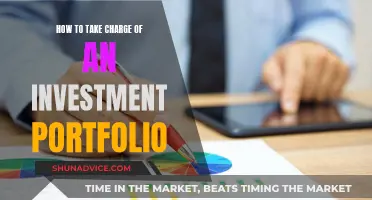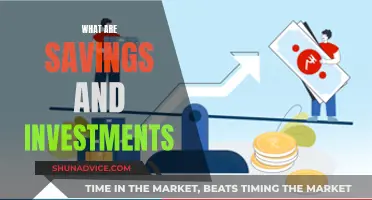
Wine is an alternative investment that can help diversify your portfolio. Its value is generally unrelated to economic factors, interest rates, or other traditional metrics. Wine investments have a medium- to long-term horizon and can be lucrative if you know what to look for.
When building your wine investment portfolio, it's important to consider your goals, budget, storage options, and the types of wine you want to include. You should also familiarise yourself with proper storage and handling techniques, insurance, and other considerations.
There are several ways to invest in wine: buying, storing, and selling individual bottles; investing in stocks of companies in the wine industry; investing in mutual or exchange-traded funds; or working with a service that manages and insures your wine collection.
Before investing, it's crucial to research the market, understand the factors that influence wine values, and be aware of the risks involved, such as breakage or improper storage, which can affect the value of your investment.
| Characteristics | Values |
|---|---|
| Investment type | Alternative investment to traditional vehicles like stocks and bonds |
| Investment benefits | Diversifies a portfolio; not tied to economic factors, interest rates, or traditional metrics |
| Investment options | Buy, store, and sell individual bottles; invest in stocks of companies involved in the wine industry; invest in mutual or exchange-traded funds; work with a service that manages, stores, and insures a wine collection |
| Investment risks | Medium- to long-term; risk of breaking, damaging, or improperly storing the bottles; no guarantee of value increase |
| Investment costs | High initial investment; buyer's premium; shipping costs; storage costs; insurance |
| Investment research | Ratings and scarcity; wine critics rate wines on a scale of 1-100; wines that rate around 95 are considered high quality |
| Investment storage | Dark area with optimal temperature and humidity levels; wine cellar; wine cooler; wine rack |
| Investment time horizon | Medium- to long-term |
What You'll Learn

How to choose wines with investment potential
When it comes to choosing wines with investment potential, there are several key factors to consider. Here are some detailed guidelines to help you make informed decisions:
- Understand the differences between fine wine and mass-market wine: Fine wines, which are the focus of investment, differ from mass-market wines in their ability to age, their value on the secondary market, and the producer's long track record of excellence.
- Focus on renowned wine-producing regions: Most collectors seek investment-grade wines from famous regions, primarily France. Bordeaux and Burgundy are typically at the top of the list, with other French regions like Champagne also offering vintage wines that age well and are relatively scarce.
- Consider scarcity and reputation: The top drivers of value for investment-grade wines include vintage quality, provenance, rarity, and the ability to age. Scarcity can significantly influence prices. For example, lower production volumes can drive up the value of specific wines.
- Study vintage reports: Pay close attention to vintage variation reports, as these can help you decide whether to purchase one or two cases of a particular wine. Vintage is the year in which grapes are harvested and produced in a specific region, and the quality of the harvest can vary annually due to weather conditions.
- Select wines with a strong reputation and track record: The reputation and track record of both the wine producer and the specific wine are crucial. Leading producers like Domaine de la Romanée-Conti (DRC), Pétrus, Château Mouton Rothschild, and Château Lafite Rothschild are often sought-after by investors.
- Understand the wine's ageing potential and longevity: Ageing potential is critical for fine wine investments. Factors such as the type of grape, acid levels, and tannins can influence a wine's potential to age well. Additionally, consider the producer's history of creating wines that age gracefully.
- Examine scarcity and price history: Wine scarcity can drive up the value of your investment. Assess the production volume and historical prices of the wines you're considering. Wines with a steady upward price trend are more likely to be worthwhile investments.
- Follow wine critics and ratings: The opinions of renowned wine critics like Robert Parker, James Suckling, and Jancis Robinson can significantly impact a wine's potential appreciation. Their ratings and reviews are taken seriously by buyers and can influence purchasing decisions.
- Educate yourself about the market: Arm yourself with as much knowledge as possible about the wine market. Define your interests, budget, time horizon, and return objectives. Seek out reputable books, publications, and websites dedicated to wine investing to enhance your understanding of the market and specific wines.
- Consider your personal preferences: If you are a wine connoisseur, you may want to choose wines that align with your tastes. Investing in wines you personally enjoy adds an element of hobbyism to your financial endeavours.
- Diversify your wine selections: As with any investment, diversification is essential. Consider investing in wines from different regions, producers, and vintages to spread your risk and maximise potential returns.
- Be prepared for the long-term: Wine investments typically have a medium- to long-term horizon. Be prepared to hold your wine investments for at least five years, and ideally longer, to allow them to mature and reach their peak value.
Investment-led Savings: The Economy's Driving Force
You may want to see also

The pros and cons of buying bottles vs stocks/funds
There are several ways to invest in wine, including buying and selling individual bottles, investing in stocks of companies involved in the wine industry, or investing in wine funds. Each option has its own advantages and disadvantages that investors should consider before making any decisions.
Pros of buying bottles
- Wine is a tangible asset that can be owned, stored, and displayed.
- Wine has a low correlation to equities and other traditional asset classes, providing diversification to an investment portfolio.
- Wine is a recession-resistant asset that can provide stability and protection during financial downturns.
- Wine can be consumed and enjoyed, providing a unique experience that other investments cannot offer.
Cons of buying bottles
- Buying and storing individual bottles of wine can be expensive, with costs including insurance, storage, and shipping.
- Wine bottles are delicate and can be easily damaged or broken, affecting their value.
- The wine market is illiquid, making it difficult to convert wine bottles into cash quickly without a significant loss in value.
- The wine industry is prone to fraud and counterfeiting, which can be a risk for inexperienced investors.
Pros of investing in stocks/funds
- Wine stocks and funds provide exposure to the wine industry without the challenges and costs associated with owning physical bottles.
- Wine stocks and funds are more liquid than physical bottles, making it easier to enter and exit the market.
- Wine stocks and funds are typically more affordable than buying individual bottles, making them accessible to a wider range of investors.
- Wine stocks and funds can be managed by professionals, reducing the time and effort required by the investor.
Cons of investing in stocks/funds
- Wine stocks and funds may not provide the same level of diversification as owning physical bottles due to their correlation with other stocks and financial markets.
- Wine stocks and funds may not offer the same level of control and decision-making as buying individual bottles.
- Wine stocks and funds may have higher fees and expenses associated with management and administration.
- Wine stocks and funds may not provide the same level of tangible benefits, such as the ability to consume and enjoy the wine.
Understanding Investment Strategies: Model Portfolios Explained
You may want to see also

The costs of storing and insuring your wine
Storing and insuring your wine collection is an important aspect of investing in wine. Proper storage is crucial for maintaining the value of your wine, as the best investment-grade wines will lose value if not stored properly.
If you don't have a place to store wine yourself, you can consider renting a wine locker or space at a storage facility. These climate-controlled warehouses are designed specifically for storing fine wines at the ideal humidity and consistent temperature. Most wine lockers will let you rent either an entire locker or some space for storing a wine case, but they usually don't accept individual bottles. Renting a wine locker also provides added services like expert maintenance and 24/7 security.
Another option for storing your wine collection is to rent space from another wine collector. This method may be more affordable, but it may not offer the same assurance and security as professional wine storage facilities.
The cost of storing your wine collection will depend on the size of your collection and the facility you choose. Additionally, you may need to factor in the cost of insurance, as some wine storage facilities offer insurance as an add-on service.
When it comes to insuring your wine collection, you can consider a personal articles floater, which is an add-on to your standard homeowners insurance policy. This type of insurance typically covers items worth $5,000 to $50,000 and can provide bottle-by-bottle coverage or blanket coverage for all the bottles in your collection. For more valuable collections, you may want to consider specialty wine insurance, which can be purchased as blanket coverage or bottle-by-bottle coverage. The cost of specialty wine insurance is typically between 40 cents to 80 cents per $100 worth of wine.
It's important to note that wine insurance may not cover all types of damage or loss. For example, most homeowners insurance policies don't cover common threats to wine collections, such as flood damage, mechanical breakdowns, or power outages. Be sure to carefully review the terms and conditions of any insurance policy before purchasing it.
In addition to the cost of storage and insurance, there are also other costs associated with investing in wine, such as shipping costs and the initial investment, which can be quite high for fine wines.
Land Investment: A Guide to Expanding Your Portfolio
You may want to see also

How to sell your wine
Selling your wine collection can be a convenient way to downsize or monetise your investment. There are several options available to you, from online wine retailers to specialist wine buyers. Here are some steps to help you sell your wine effectively:
Appraise Your Collection
Before selling, it is important to have a clear understanding of the value of your wine collection. You can submit your collection for appraisal to online wine retailers, such as Wine.com, or specialist buyers, such as Sokolin. These companies will assess the value of your wine based on current market rates and their ability to sell it swiftly. They will consider factors such as the vintage, rarity, and condition of the wine to determine its worth.
Prepare Your Inventory
Create an accurate inventory of your wines, including details such as the number of bottles, vintages, and any relevant information about their storage and provenance. This will help potential buyers evaluate your collection and ensure you receive a fair price. Ensure your bottles are worth $75 or more and have a combined value of at least $15,000, as some buyers may have minimum requirements.
Choose a Selling Platform
You can sell your wine through online retailers, auction houses, or specialist wine buyers. Online retailers like Wine.com offer a convenient option, taking care of appraising, marketing, and selling your collection. They have a large network of collectors and can get you top dollar without the risk of high commissions associated with auction sales. Specialist buyers, such as Sokolin, also offer guaranteed prices upfront without any hidden fees and prompt payment upon inspection and verification of your collection.
Understand Selling Strategies
Selling strategies can vary depending on the platform you choose. Online retailers may establish an acquisition cost and selling price for your wine based on their network and marketing reach. Specialist buyers may devise a selling strategy tailored to your needs, whether through retail sale or consignment. They will monitor market pricing and conduct extensive research to get you competitive prices.
Consider Shipping and Insurance
If you choose to sell through a specialist wine buyer, they may offer packing services and insurance during transit. This can be a convenient option, especially if you have a large collection. Ensure you understand the shipping and insurance processes to protect your wine during transportation.
Finalise the Sale
Once your collection has been appraised, inspected, and verified, you will receive payment for your wine. The payment method may vary depending on the buyer, but it is typically made via wire transfer or check. Ensure you understand the payment process and any associated fees or charges before finalising the sale.
Rebalancing Your Investment Portfolio: How Often is Necessary?
You may want to see also

How to spot a fake wine
- Beware of "unicorn" wines that never existed. For example, a five-litre bottle of Cheval Blanc 1945, as the bottle size wasn't introduced in Bordeaux until 1978.
- Check the label colour. Paper has changed over the years, with a formula called "ultrawhite" introduced in 1957. This fluoresces under blue light, so if you've got an ultrawhite label on a bottle from the 1940s or 1950s, it's likely a fake.
- Read the small print. Most fine wine labels use a plate press, so look closely for colour separation from a three-colour screen process, or squared edges from a dot matrix.
- Get your facts straight. Does the label information match the history? For example, a Lafite 1811 vintage would not mention the Pauillac AOC, dating from 1936, or the Rothschild family, who owned it from 1868.
- Counterfeiters use various techniques to make new labels look old. Staining from tobacco, dirt from shellac, and the characteristic grooved marks from sandpaper are all common. Some labels, oven-baked in batches, show the "ghost" of another label under close examination.
- Glue can be forensically aged. The classic "white" glue was used from the 1960s and, like ultrawhite paper, fluoresces under blue light. Be wary of glue stains around label edges, in nicks and tears, and under capsules.
- Over the years, food packaging laws have dictated a switch from lead to tin to aluminium. If a capsule has multiple creases, it's probably been reapplied. Other giveaways include thumbprints on wax capsules, residue from a previous closure, or a recycling logo on an old bottle.
- Bordeaux corks are typically 52-55mm long and are branded, rather than inked. Check for "Ah-so" marks – the grooves left by a two-pronged cork puller. For corks made from agglomerate, look for dirt under the capsule masking the cork.
- A hand-blown bottle from the 19th century tends to wobble on a flat surface. Post-1930, French bottles should have their capacity (e.g. 75cl) embossed somewhere on the glass.
- Wine sediment is hard to fake, so check for its presence, size, and general appearance. Is it too chunky? Some fake sediment sparkles like glitter under light.
- Trust your gut. If a deal seems too good to be true, it probably is. Be wary of stories about miraculous finds of rare wines.
Savings vs. Investment Institutions: Where Should Your Money Go?
You may want to see also
Frequently asked questions
Before investing in wine, you should be prepared to wait at least 5-10 years before selling. You should also be aware of the costs of building and maintaining a wine cellar, as well as insurance costs. It is recommended to have a minimum of 3 bottles of investment-grade wine, and to use professional storage solutions to guarantee excellent provenance and maximise your chances of selling.
Investment-grade wines are distinguished from mass-market wines by their ability to age, their value on the secondary market, and the producer's long track record for excellence. The most in-demand investment wines are fine Bordeaux and Grand Cru Burgundy, which start at $600 per bottle and are offered in 6-bottle wooden boxes.
The top drivers of value for investment-grade wines are vintage quality, provenance, rarity, and the ability to age. Scarcity can also drive up prices. For example, in 2012, Domaine de la Romanée Conti in Burgundy produced fewer than 4,500 bottles, which now sell for upwards of $13,000 per bottle.
You can buy wines directly through distributors, auction houses, or the secondary market via fine wine retailers. You can also buy wines en primeur, or through wine futures, which allow you to invest in wine while it is still in the barrel. Alternatively, you can invest in wine stocks, funds, or mutual funds targeting sin stocks, the consumer staples industry, or other themes that may include wine.
Wine investments tend to be medium to long-term, and there is a risk of breaking, damaging, or improperly storing the bottles, which can nullify their value. As with all investments, there is no guarantee that the value of any specific bottle of wine will increase.
In the US, you will likely be selling your wine through an auction of some kind. Online wine auctions act a little more like eBay than a traditional auction. There are many different auction houses, including Vinofolio, Acker Merral & Condit, K & L Wine Merchants, Christie's, and Spectrum Wine Auctions. The auction house will take a cut of the sale, with commissions ranging from 0% (if you accept store credit) to 20% of the sale.







